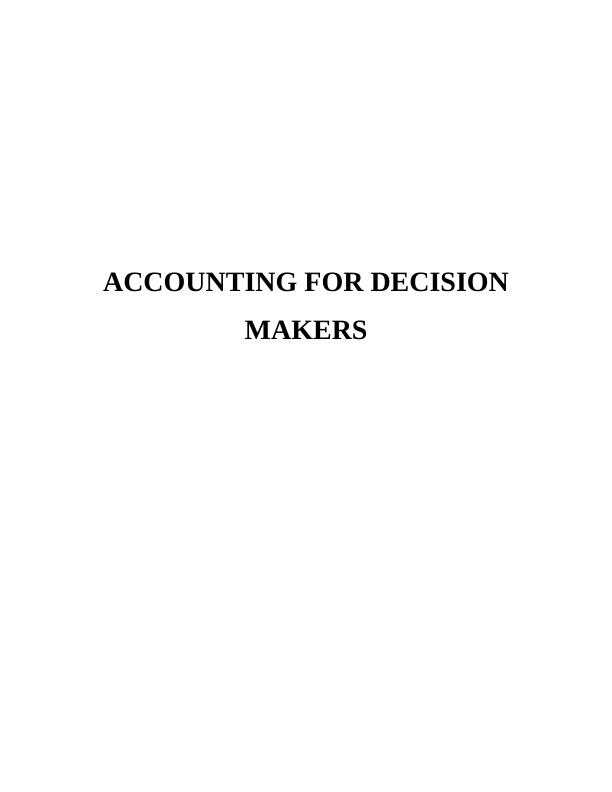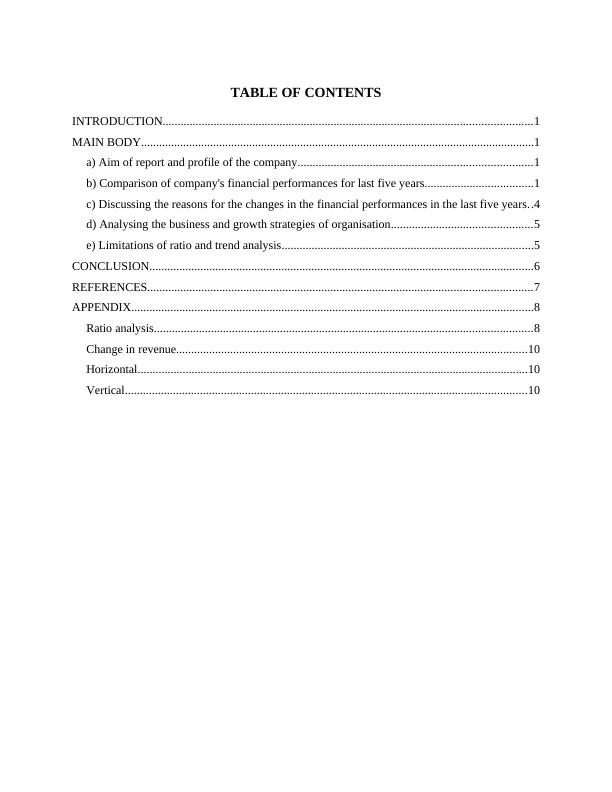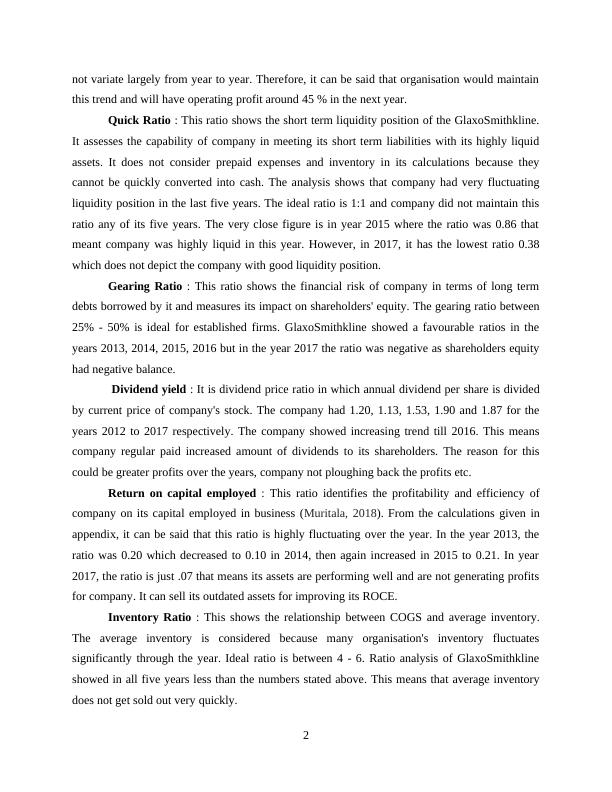Accounting for Decision Making Assignment Solution
Added on 2020-10-05
13 Pages3176 Words481 Views
ACCOUNTING FOR DECISIONMAKERS

TABLE OF CONTENTSINTRODUCTION...........................................................................................................................1MAIN BODY...................................................................................................................................1a) Aim of report and profile of the company..............................................................................1b) Comparison of company's financial performances for last five years....................................1c) Discussing the reasons for the changes in the financial performances in the last five years..4d) Analysing the business and growth strategies of organisation...............................................5e) Limitations of ratio and trend analysis....................................................................................5CONCLUSION................................................................................................................................6REFERENCES................................................................................................................................7APPENDIX......................................................................................................................................8Ratio analysis..............................................................................................................................8Change in revenue.....................................................................................................................10Horizontal..................................................................................................................................10Vertical......................................................................................................................................10

INTRODUCTIONFinancial performance of a company shows its profitability for a particular period and itsposition for a particular date. The performance is analysed for making decisions regarding itsgrowth and other corporate strategies (Uechi and et.al., 2015). The present report is going tocover the financial analysis of GlaxoSmithkline Plc, a British pharmaceutical organisationheadquartered in Brentford, London. The assignment will cover the ratio analysis of company,trend analysis, analysis of company's growth strategy and limitations of ratio and trend analysis. MAIN BODYa) Aim of report and profile of the companyThe aim of the report is to analyse the financial performance of the GlaxoSmithkline bythe way of conducting ratio and trend analysis. Trend analysis is a method of predicting thechanges in prices of stock in the future. Through ratio analysis, company's performance would beassessed in terms of its profitability, solvency, etc. The report will also highlight the corporatestrategy of company, it has been using in the recent years. GlaxoSmithkline is a British pharmaceutical company that is publicly traded on the stockexchanges. The company has its headquarters in London, UK. It is a result of merger betweenGlaxo Wellcome and Smith Kline Beecham in 2000. It is one of world's biggest pharmaceuticalcompany operating globally. It has an employee strength of about 99000. b) Comparison of company's financial performances for last five yearsRatio analysis of GlaxoSmithkline is provided below: Gross profit ratio : This ratio depicts the relationship between gross profit and net salesof a company (Sani, Amboningtyas and Yulianeu, 2018). As per the table in appendix,GlaxoSmithkline's profitability ratio in the year 2013 to 2017 were 67.61%, 68.17%, 62.99%,66.69%,65.74% respectively. It can be seen that ratios are showing stability over the years. Thisis due to stable sales in the last five years and controlled direct expenses. It is estimated thatcompany will continue this trend in its profitability in the future. Operating profit ratio : This ratio reflects the contribution of operating expenses incompany's operating income. The ratios for the five years 2013, 2014, 2015, 2016, 2017 were45.33%, 49.45%, 52.01%, 45.08%, 45.66% respectively. The operating profit in the year 2015was highest and others years showed a stable trend. This meant that company's expenses in thesefive years did not fluctuate to a significant level and also firm has managed to make sales that did1

not variate largely from year to year. Therefore, it can be said that organisation would maintainthis trend and will have operating profit around 45 % in the next year.Quick Ratio : This ratio shows the short term liquidity position of the GlaxoSmithkline.It assesses the capability of company in meeting its short term liabilities with its highly liquidassets. It does not consider prepaid expenses and inventory in its calculations because theycannot be quickly converted into cash. The analysis shows that company had very fluctuatingliquidity position in the last five years. The ideal ratio is 1:1 and company did not maintain thisratio any of its five years. The very close figure is in year 2015 where the ratio was 0.86 thatmeant company was highly liquid in this year. However, in 2017, it has the lowest ratio 0.38which does not depict the company with good liquidity position.Gearing Ratio : This ratio shows the financial risk of company in terms of long termdebts borrowed by it and measures its impact on shareholders' equity. The gearing ratio between25% - 50% is ideal for established firms. GlaxoSmithkline showed a favourable ratios in theyears 2013, 2014, 2015, 2016 but in the year 2017 the ratio was negative as shareholders equityhad negative balance. Dividend yield : It is dividend price ratio in which annual dividend per share is dividedby current price of company's stock. The company had 1.20, 1.13, 1.53, 1.90 and 1.87 for theyears 2012 to 2017 respectively. The company showed increasing trend till 2016. This meanscompany regular paid increased amount of dividends to its shareholders. The reason for thiscould be greater profits over the years, company not ploughing back the profits etc.Return on capital employed : This ratio identifies the profitability and efficiency ofcompany on its capital employed in business (Muritala, 2018). From the calculations given inappendix, it can be said that this ratio is highly fluctuating over the year. In the year 2013, theratio was 0.20 which decreased to 0.10 in 2014, then again increased in 2015 to 0.21. In year2017, the ratio is just .07 that means its assets are performing well and are not generating profitsfor company. It can sell its outdated assets for improving its ROCE.Inventory Ratio : This shows the relationship between COGS and average inventory.The average inventory is considered because many organisation's inventory fluctuatessignificantly through the year. Ideal ratio is between 4 - 6. Ratio analysis of GlaxoSmithklineshowed in all five years less than the numbers stated above. This means that average inventorydoes not get sold out very quickly. 2

End of preview
Want to access all the pages? Upload your documents or become a member.
Related Documents
Accounting and finance -assignmentlg...
|10
|1612
|33
Financial Performance Analysis of GlaxoSmithKline Plclg...
|20
|1782
|184
Financial Analysis Management & Enterprise- Assignmentlg...
|36
|6391
|129
(PDF) Analysis of financial statementslg...
|15
|4031
|157
Research Study - Ratio Analysis & Business Performance Measuredlg...
|12
|3877
|41
THE MANAGE FINANCIAL PERFORMANCElg...
|36
|9609
|13
